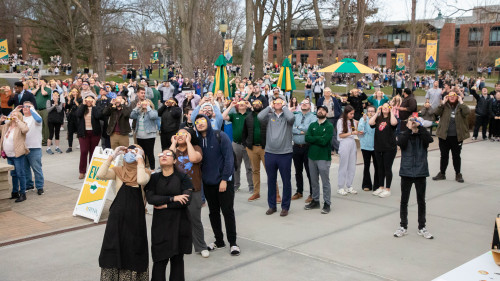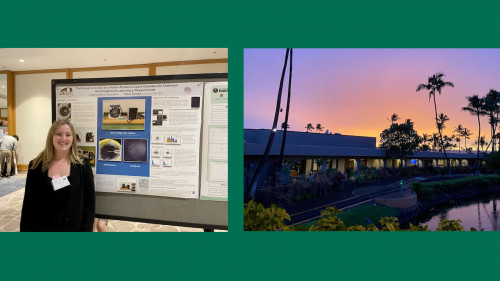
Ranked among the Elite 3% of College’s in America: Siena’s Portal to the Universe
The Wall Street Journal lists Siena 91st on its Best Colleges in the U.S. rankings, which places Siena among the top 3% of institutions in the galaxy. Speaking of galaxies, all eyes in the astronomical world are focused on the Siena Galaxy Atlas.
A digital atlas of almost 400,000 nearby galaxies is live online and can be accessed by the public – and referenced by astronomers – around the world. To honor the home institution of the project leader whose ongoing research informed its content, it is known as the Siena Galaxy Atlas (SGA).
John Moustakas, Ph.D., professor of physics and astronomy, and a team of scientists compiled the SGA using data from a worldwide network of telescopes operated by the National Science Foundation's NOIRLab. The online atlas has been featured throughout this week on scientific sites such as space.com and Symmetry Magazine, thanks to the academic article with Moustakas as the lead author being published October 18 by The Astrophysical Journal, the premier journal in the field.
“Nearby large galaxies are important because we can study them in more detail than any other galaxies in the universe; they are our cosmic neighbors,” explained Moustakas. “Not only are they strikingly beautiful, but they also hold the key to understanding how galaxies form and evolve, including our very own Milky Way galaxy.”
NOIRLab noted that the Siena Galaxy Atlas is designed to be the pre-eminent digital galaxy atlas for large galaxies, “a treasure trove of information for researchers investigating everything from galaxy formation and evolution to dark matter and gravitational waves.”
A large international team of scientists collaborated to gather some of the sharpest and deepest images of the sky ever taken. Technically speaking, the SGA is an atlas of 383,620 nearby galaxies located over half the sky and observed at several different parts of the electromagnetic spectrum.
Compilations of astronomical objects serve many purposes: they can help scientists spot broad patterns across a population of objects, put new discoveries such as transient events in the context of their surroundings, and identify the best candidates for focused observations. Once these objects are compiled, they must be routinely updated to reflect the continuous technological improvements of telescopes.
“This will be a boon to future astronomical inquiry,” said Moustakas, whose work was funded in part by grants from the National Science Foundation and the U.S. Department of Energy (DOE).
The SGA is a compilation of data from three surveys completed between 2014 and 2017 known as the DESI Legacy Surveys. These imaging surveys were carried out to identify galaxy targets for the Dark Energy Spectroscopic Instrument (DESI) survey, a major project funded by the DOE in which Moustakas and his students were also involved. Data were collected at the Cerro Tololo Inter-American Observatory (CTIO) in Chile and at two large telescopes Kitt Peak National Observatory (KPNO) in Arizona.
These surveys captured images in optical and infrared wavelengths to chart a total area of 20,000 square degrees — nearly half of the night sky – making it among the largest galaxy surveys. Bringing this wealth of information together in one place, the SGA offers precise data on the locations, shapes and sizes of hundreds of thousands of relatively nearby large galaxies. Besides the sheer number of objects recorded, the data in the SGA also achieve a new level of accuracy and it is the first such resource to provide data on the galaxies’ light profiles. Since the SGA uses digital images captured with highly sensitive instruments, it represents a substantial improvement in both data quality and completeness.
Over the past decade, Moustakas has worked with a number of Siena physics and astrophysics students on the SGA and DESI projects, including Keith Pritchett, Jr. ‘25. As a freshman, Pritchett worked with Moustakas to analyze galaxies in the SGA using newly released, state-of-the art software.
“Working with Dr. Moustakas using the SGA was an amazing experience,” he said. “I was able to expand my knowledge of galaxy structure, formation, and evolution. This ultimately prepared me to conduct research at the University of Texas at Austin, where I analyzed James Webb images of Milky-Way-like barred galaxy in the young universe. It’s an amazing feeling to grasp the power behind the SGA and the amount of research that Siena students can do.”
With this research experience in-hand, Pritchett was selected for a prestigious undergraduate research fellowship at the University of Texas at Austin this past summer. He analyzed images of galaxies taken with the world-class James Webb Space Telescope and will be presenting his work at the January 2024 meeting of the American Astronomical Society in New Orleans.

